By Tyler Rossi for CoinWeek …..
In 1204, Constantinople was sacked during the Fourth Crusade. Less than six months later, Enrico Dandolo, the Doge of Venice; Boniface, the Marquess of Montferrat; Baldwin, Count of Flanders; and Louis I, Count of Blois signed the Partitio terrarum imperii Romaniae. Translated as “The Partition of the lands of the empire of Romania”, this treaty saw the first official disillusion of the Byzantine Empire and established the Frankokratia, or “Rule of the Franks”.

The former Byzantine lands were chopped up and divided among the leaders of the Fourth Crusade. Given the core territories of the empire, the new Latin Empire held Constantinople and eastern Thrace. Greece proper was to be divided into a series of small states: the Kingdom of Thessalonica, the Principality of Achaea, the Duchy of Athens, and the Duchy of the Archipelago controlled by Venice.
Despite this segmentation, the Crusaders did not actually gain control of the majority of their holdings. In fact, since the exiled Byzantine Greek nobles controlled the Empire of Nicaea and Despotate of Epirus as two successor states, the Partitio’s stated divisions failed. The eastern territories, which had not been seized by the Seljuk Sultanate of Rum, were taken by the newly formed Empire of Nicaea, while the Despotate of Epirus claimed sovereignty over the western Balkan coastal region.
Venice, as the greatest beneficiary of the treaty, required that they retain all previous privileges and territories that they seized or been granted by Constantinople, as well as a vote on who would be elected as the ruler of the new Latin Empire.
The Latin Empire
This feudal Crusader state, holding roughly 25% of the old Byzantine lands, acted as Western Europe’s official replacement of the Byzantine Empire. This ensured that the region would be ruled by a Catholic emperor. The Empire would have six rulers during its short 57-year existence.
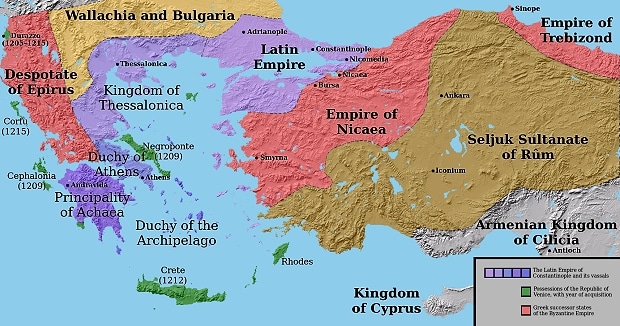
The Latin Empire did strike coins, as attested to by Niketas Choniates, a Byzantine official present at the time of conquest, in a document colloquially called De Statuis. In this document, Choniates discussed multiple times how the crusaders melted “large statues of great artistic value” and used the metal to strike “coins of little value” (Stahl, 199). This description, however, was perhaps based more on Choniates’s distain for the invaders than as an official report on minting activities.
The pre-invasion monetary system of coinage in Byzantium was based on a hyperpyron of “good but not pure gold” (Stahl, 197). This coinage was mostly halted after the invasion, and a general lack of domestic coinage “created a vacume of circulating medium” (Stahl, 205). Despite this, there is no significant evidence that coins of the Successor states’ of Nicaea and Epirus “played a significant role in the monetary life of the Latin Empire” (Stahl, 200). Instead, the economy was serviced mostly by imported Venetian silver coins, pre-existing Byzantine coins, Western European silver, and uncoined ingots or plate silver.
Of the coins struck by the Latin Empire, there are “no surviving coins that bear the names of their emperors,” which has led to extensive disagreement on the chronology of said coinage (Stahl, 197). For example, this silver trachy struck in Constantinople displays a nimbate bust of Christ facing on the obverse and the Archangel Michael on the reverse.
Kingdom of Thessalonica
Not to be confused with the later Empire of Thessalonica, which was a short-lived puppet state of the Despotate of Epirus, the Kingdom of Thessalonica was founded in 1204 by Boniface of Montferrat who led the Fourth Crusade. Located within the Latin Empire, Boniface was technically a subordinate of his rival, Baldwin. In fact, he was never officially crowned and instead ruled as a titular king. While he reigned for only three years, Boniface was able to expand his control to most of northeastern Greece including Thessaly, Boeotia, Euboea, and parts of Attica.
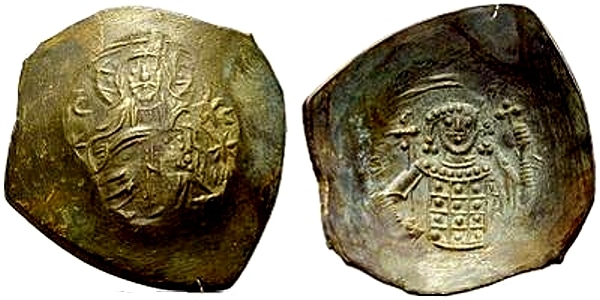
After Boniface was killed by the forces of the Bulgarian Tsar Kaloyan on September 4, 1207, his infant son Demetrius was placed on the throne. Following the age-old tradition of child rulers being influenced by courtiers, Demetrius was a puppet for most of his reign. But immediately after Boniface was killed, Michael I of Epirus and the Bulgarians both invaded. While they were initially unsuccessful, Theodore of Epirus eventually conquered the kingdom, and with the capture of Thessalonica in 1224, Theodore exiled Demetrius, who fled to the court of Emperor Frederik II.
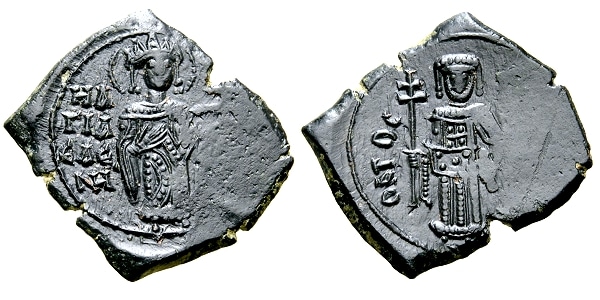
Empire of Nicaea
Founded in 1204 by Theodore I Laskaris, the son-in-law of the previous Byzantine emperor, the Empire of Nicaea controlled northwestern Anatolia and lasted until the Byzantine Empire was restored in 1261. While not initially successful, the Empire grew in strength and became quite a powerful entity after the Latin emperor Baldwin I was defeated by the Bulgarian army at the Battle of Adrianople in 1205. Despite this success, the Empire did not have a strong financial position and had difficulties maintaining the quality of its coinage. For example, the electrum used in this Aspron Trachy of John III Doukas Vatatzes (r. 1222-1254) was quite “silvery” and contained almost no gold (LHS Numismatik).
The Despotate of Epirus
Similarly to the Empire of Nicaea, the Despotate of Epirus was founded in 1204 by an exiled branch of the Byzantine Angelos dynasty. Initially ruling modern day Albania, western Greek Macedonia, Thessaly, and parts of western Greece, the Empire pursued an aggressive policy of expansion. By 1230, Theodore Komnenos Doukas (r. 1224-1230) had conquered central Macedonia, Thessalonica, and Thrace as far as Adrianopolis. He was incredibly close to conquering Constantinople itself. This dramatic expansion into Latin Empire territory was made possible due to the growing threat of the Empire of Nicaea. Theodore was so successful that he crowned himself Byzantine emperor in 1225. He was, however, captured shortly thereafter by the Bulgarians and held captive until 1237.
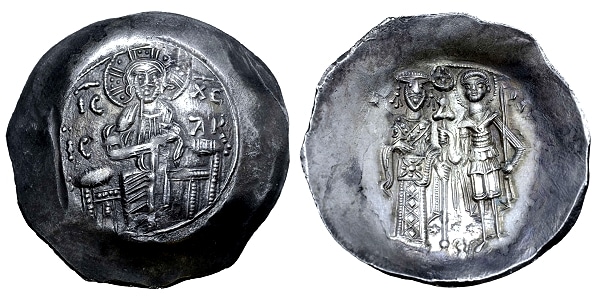
After his defeat and capture in 1230, the state was quickly forced back to its original borders. It was not reclaimed by the resurgent Byzantine Empire until 1337.
Much of the later coinage of the Despotate, like this billon denier tournois of John II Orsini, resembled contemporary Western European coinage as a result of the influence of imported Crusader currency from France. It also made it easier for Epirus to trade with its neighboring Crusader states.
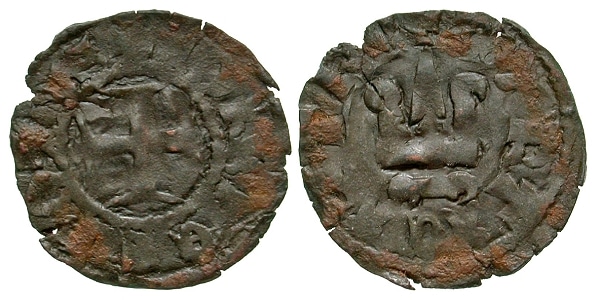
The Principality of Achaea
Founded by William I in 1205, the Principality of Achaea was a small state controlling the central Peloponnese (Morea) and was a vassal state of the Kingdom of Thessalonica. While geographically small, after Theodore of Epirus captured Thessalonica and released Achaea from Thessalonian suzerainty in 1224, it became the leading authority in Greece. This was due to its relative wealthy nature and ability to help secure the Latin Empire against the Empire of Nicaea. After a series of battles against Venice and Nicaea, the fourth prince of Achaea, William II (r.1246-1278), was captured by Nicaean forces.

Despite William’s capture and the resurgent Byzantine Empire, the Principality successfully struggled to hold off Byzantine control until 1432. However, from the early 14th century to the Byzantine reconquest, the Principality was shaken by violent succession disputes between Italian princes. Despite this century of violence, Achaean coinage flourished. In fact, it was not unusual for coins imitating Venetian ducats to be struck in an effort to facilitate trade. Below is an example struck by Robert de Taranto (r. 1333-1364), imitating a gold ducat of Andrea Dandolo, the Doge of Venice.

Duchy of Athens
Lasting from 1205 to 1458, the Duchy of Athens was controlled by the Burgundian de la Roche family, Sicilian kings, and the Florentine Acciaioli family. Covering parts of Attica and Boeotia, the Duchy was originally a vassal of the Kingdom of Thessalonica. But when Thessalonian power was broken, the Principality of Achaea seized overlordship.
Slightly later in 1267, Charles I of Sicily became dominant the area. Yet the La Roche family continued to rule Athens until 1308, when the Catalan mercenary company took control. In 1312, the king of Sicily seized direct control and made his son duke. It wasn’t until 1388 that the Florentine Acciaioli family captured the city. Their control however would not last long, and the Duchy became a tributary of the Byzantine Empire in 1444.
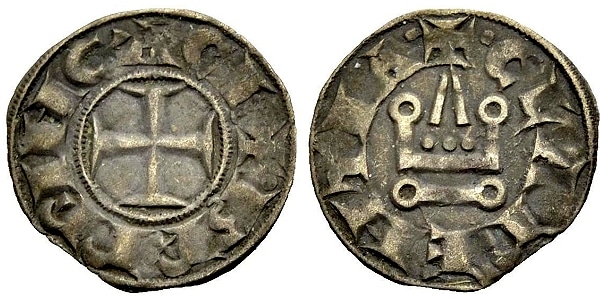
Duchy of the Archipelago
Covering the Cyclades, Naxos, and Paros, the Duchy was created to extend Venetian dominance. The Duchy would go on to the longest lasting crusader state formed by the Fourth Crusade, and it wasn’t until the Ottomans formally annexed the islands in 1579 that the Duchy was dissolved. This period of rule can be broken down into three main periods: the Sanudo dynasty (1207-1383), the Crispo Dynasty (1383-1494), and the Ottoman conquest (1566-1579).
This article is only a very brief introduction to an extremely interesting period of history, full of complex interstate conflicts that resulted in a range of remarkable coins. Coins produced during this time period run the gamut from well-struck pieces to those that have soft details and were extremely poorly struck. The mix of Western European designs brought by the Crusaders and traditional local Byzantine imagery shows how disruptive these years were to the region.
There is a coin for every numismatist from this period. Happy collecting!
* * *
Sources
LHS Numismatik – https://www.acsearch.info/search.html?id=298132
https://www.ahistoryofgreece.com/byzantine.htm
http://www.hellenicaworld.com/Byzantium/History/en/PrincipalityOfAchaea.html
* * *
About the Author
Tyler Rossi is currently a graduate student at Brandeis University’s Heller School of Social Policy and Management and studies Sustainable International Development and Conflict Resolution. Before graduating from American University in Washington D.C., he worked for Save the Children creating and running international development projects. Recently, Tyler returned to the US from living abroad in the Republic of North Macedonia, where he served as a Peace Corps volunteer for three years. Tyler is an avid numismatist and for over a decade has cultivated a deep interest in pre-modern and ancient coinage from around the world. He is a member of the American Numismatic Association (ANA).




